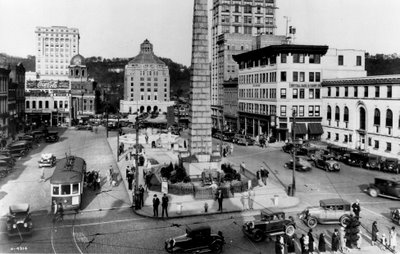
Part One and explanation here
Parts Two and Three here
Asheville - 1900-1920
"As the 1900s approached, Asheville's economic growth exploded. Religious assemblies, an opera house and a convention auditorium drew urban culture to the area. The "Asheville Board of Trade," developed by the Chamber of Commerce in 1900, devised national advertising campaigns labeling Asheville one of "the leading convention cities in the country."
 The best-selling short story writer, O. Henry, came to Asheville and Hot Springs in 1908 seeking a cure for his neurasthenia. Rejecting medicines, he yielded to the counsel of mountain doctors who prescribed nature walks, another tradition. Before colonization of this area, William Bartram, world-famous botanist, had walked these wilds and discovered their unrivaled variety of plant life. His "Travels" serves as a bible for today's herb-seekers and conservationists.
The best-selling short story writer, O. Henry, came to Asheville and Hot Springs in 1908 seeking a cure for his neurasthenia. Rejecting medicines, he yielded to the counsel of mountain doctors who prescribed nature walks, another tradition. Before colonization of this area, William Bartram, world-famous botanist, had walked these wilds and discovered their unrivaled variety of plant life. His "Travels" serves as a bible for today's herb-seekers and conservationists.The church community, at the heart of Asheville history and architecture, reveals powerful stories of sanctuaries and the architects who constructed them. Spanish designer Rafael Guastavino incorporated distinctive stylistic techniques to construct the St. Lawrence Catholic Church in 1909, recently awarded the distinction of minor basilica. Sheathed in pink, green, brown and white tiles, two Spanish Baroque towers distinguish the church as a true architectural masterpiece. Using a method he devised called "cohesive construction," Guastavino built a dome measuring 52 feet by 82 feet�the largest unsupported tile dome in the United States.
Architects Richard Sharpe Smith, Douglas Ellington, and Ronald Greene designed buildings that would, one day, augment Asheville's diverse city center. Today, structures such as City Hall, the Jackson Building, First Baptist Church and the S & W Building help downtown Asheville retain a southeastern Art Deco collection second only to that of Miami Beach. The Langren Hotel in 1912, Grove Park Inn in 1913, and the Kenilworth Inn in 1918 served to expand further the luxury resort industry in Asheville. The most enduring of these, the Grove Park Inn, was founded in part because of a case of bronchitis.
 In his travels, Edwin Wiley Grove visited and became enamored with a rustic, yet grand mountain lodge at Yellowstone Park.
In his travels, Edwin Wiley Grove visited and became enamored with a rustic, yet grand mountain lodge at Yellowstone Park.Grove searched in vain for an architect who could design a luxurious inn suitable for a mountain setting. Angry and frustrated by the fruitless endeavor, Grove turned to his son-in-law and Atlanta journalist Fred Seely, a young man with no architectural experience. The novice builder specified granite boulders from Sunset Mountain on which the inn was built, and red clay tiles from Tennessee to accentuate the extravagant hotel.
The Grove Park Inn Resort endures today as an historical site in Asheville, welcoming guests with a celebrity hall of famous visitors including: Mikhail Baryshnikov, Burt Reynolds and George Bush. The Rogues Gallery features photographs of famous visitors from the early 1900s including Calvin Coolidge, Henry Ford, Thomas Edison, Will Rogers and dozens of others.
The Asheville Tourists hit the scene in 1915 and moved to newly constructed McCormick Field in 1924."
3 comments:
Screwy,
I enjoy these Asheville history postings.
8-) good. me too.
i heard somewhere that guastavino is actually ensconced within the walls of st. lawrence basilica but i could be wrong...
Post a Comment